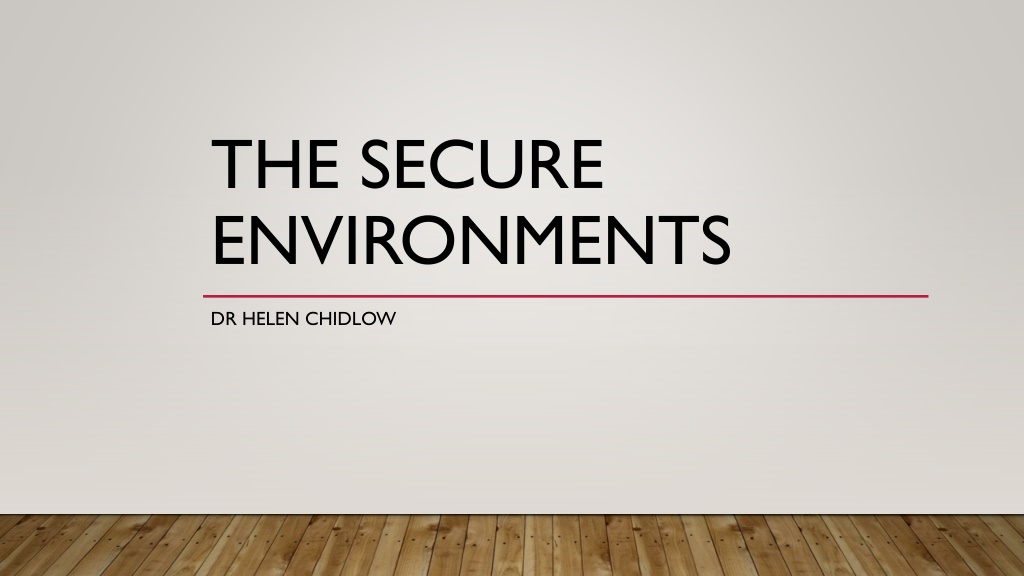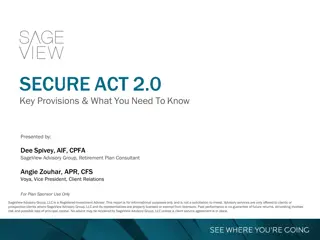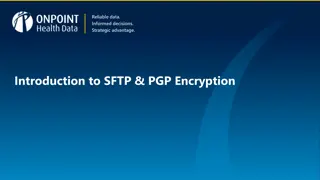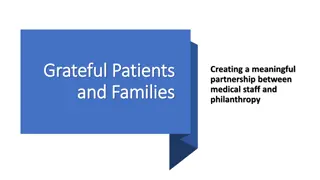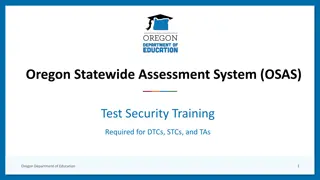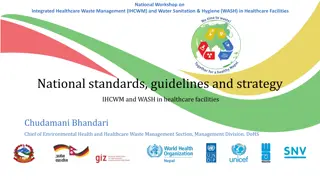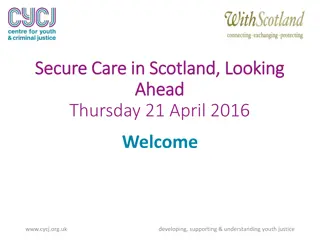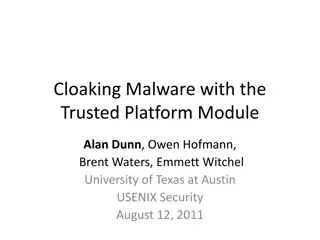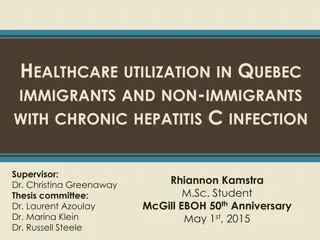Healthcare Challenges in Secure Environments
The secure environments of prisons, secure mental health hospitals, young offenders institutions, and immigration centers face various healthcare challenges. The aim is to provide healthcare equivalent to that in the wider community. Background information highlights the evolution of healthcare in prisons, different models in place, and prison classifications based on security risk. The worldwide prison population statistics and the UK situation shed light on overcrowding, deaths in custody, recruitment difficulties, and prisoner demographics. Primary care in prisons focuses on a primary care model, multidisciplinary team approach, balancing justice and health needs, and the presence of mental health services.
Download Presentation

Please find below an Image/Link to download the presentation.
The content on the website is provided AS IS for your information and personal use only. It may not be sold, licensed, or shared on other websites without obtaining consent from the author.If you encounter any issues during the download, it is possible that the publisher has removed the file from their server.
You are allowed to download the files provided on this website for personal or commercial use, subject to the condition that they are used lawfully. All files are the property of their respective owners.
The content on the website is provided AS IS for your information and personal use only. It may not be sold, licensed, or shared on other websites without obtaining consent from the author.
E N D
Presentation Transcript
THE SECURE ENVIRONMENTS DR HELEN CHIDLOW
WHAT ARE THE SECURE ENVIRONMENTS Prisons Secure Mental health hospitals Young Offenders Institutes Immigration Centres
THE AIM It is well recognised from a legal perspective at international, regional (European) and local (UK) levels that health care provision in secure environments should be of an equivalent standard to that provided in the wider community. We recognise the benefit to our patient group by striving for equivalent care and furthermore recognise the benefits this provides to our society as a whole
BACKGROUND OF HEALTHCARE IN PRISONS Transferred to NHS in 2006 Prior to this medics were employed directly by the prisons. Now several different models 1. NHS 2. 3rdSector 3. Private providers
PRISON CLASSIFICATIONS Split into categories defined in part by security risk risk to public if they were to ecscape Cat A Cat B Cat C Cat D Womens estate Young peoples Young offenders and Youth Custody Secure Mental Health units
WORLDWIDE PRISON POPULATION 11+ million people in prison 0.5 million life sentences increased by 84% in 14 years 50% have committed a non violent crime 20% on drugs charges of which 83% personal possession Only 7% homicide 50% increase in women in prison 19,000 children in prison with mothers
UK SITUATION 60% prisons are over crowded Deaths in custody are increasing Recruitment to healthcare jobs very difficult The average prisoner is more likely to have been homeless, unemployed and in social care as a child. Over representation of BAME especially Black population High turnover and in 2011 nearly 50% were in for less than 6 months Many prisons built in 1870s still in use
PRIMARY CARE IN PRISONS Centred around a primary care model Heavily reliant on a strong MDT Needs to balance between the justice requirements and the health needs of the patient Health care department Visiting consultants Strong mental health presence Seg ward rounds
MEDICAL PRESENTATIONS IN PRISONS Late presentations of disease Increased cancer diagnosis due to lifestyle factors Mental health 25 per 100,000 suicides in prison compared to 11 per 100000 in community Self harm Infectious diseases including TB Palliative Care Long Term conditions
WORKING IN PRISONS Clinical decisions and any other assessments regarding the health of detained persons should be governed only by medical criteria. Health care personnel should operate with complete independence within the bounds of their qualifications and competence European Council The relationship between health personnel and patients in prisons is not based on free will. The patient cannot choose the doctor, nor can the doctor choose the patient. This places the highest demands on the professional ethics of prison health professionals
SAFEGUARDING IN PRISONS An Adult at risk has needs for care and support (whether or not the authority is meeting any of those needs), and is experiencing, or is at risk of, abuse or neglect, and as a result of those needs is unable to protect himself or herself against the abuse or neglect or the risk of it
VULNERABLE PRISONERS A Vulnerable Prisoner is an inmate who is at risk of bullying, suicide or self-harm. There are a number of reasons why a prisoner may be classified as vulnerable during assessment on entering the prison. Only when the prisoner meets the criteria outlined above, is he identified as an adult at risk
OLDER PRISONERS Prison is estimated to add 10 15 years to chronological age. Elderly in prison is > 50 years 16% of prisoners are > 50 This is the fastest rising age group due to convictions for historical sexual abuse
LEARNING DISABILITIES 7% of prisoners are estimated to have a learning disability This compares to 2.2% of the general population There is currently no specialised provision in prisons for people with learning disabilities.
COMMUNICATION DIFFICULTIES 11% of prisoners are non UK nationals Over half (54%) of people entering prison were assessed as having very limited literacy skills similar to an 11 year old. This is over three times higher than the general adult population (Ministry of Justice and Department for Education (2017) )
FEMALE PRISONERS Although not classified as adults at risk many female prisoners have increased vulnerability. This can be for a number of reasons: Pregnancy/postnatal/breastfeeding Tend to be the family carers/separation from dependents Victims of Domestic Abuse Victims of Criminal Exploitation Street Sex Workers
TYPES OFABUSE Physical 16% in 2018 increasing Sexual -1% of prisoners have disclosed this Mate crimes Bullying and harassment Institutional
RADICALISATION 75% increase in prisoners convicted for terrorism related offences in the last 3 years 700 prisoners considered to be a risk due to their extremist views Prevent - Prevent is a UK-wide strategy, as counter-terrorism is the responsibility of the UK government. In practice it is delivered differently in the different countries of the UK as many of the organisations involved, for example the police and councils, are under the control of devolved governments.
SELF HARM AND SUICIDE 55,958 incidents of self harm in 2018 25% 3,214 incidents required hospital attendance 87 suicides in 2018 26% Cutting/scratching accounted for 68% of incidents in males and 54% in females Self harm tends to be most common between 1 3 months in custody but in 2018 > 1 year
SELF NEGLECT Self-neglect implies the inability or unwillingness to attend to one's personal needs or hygiene. It may manifest in different ways, such as not attending to one's nutrition, hygiene, clothing, or acting appropriately to care for medical conditions. Examples of self neglect in Prison: Refusal of medical treatment Refusal of food and water Dirty protesting urine and faeces smearing
COVID 19 AND PRISONS A huge challenge Prisoners confined 23 hours a day Visits suspended Increase in in cell phones have helped Restrictions in PPE Anticipated releases did not happen 57 as opposed to predicted 4000 16 in cell suicides 6 in the last week 22 prisoner deaths
DYING WELL IN CUSTODY Recognising the right to die well extends to prison Some people are not suitable for early release or may choose to die in prison Includes an open cell door for use in the last few days allow 24 hour access for healthcare Facilitate visits from family. Training needs for prisons Palliative care in reach essential.
WORKING IN THE SECURE ENVIRONMENTS Continuity of Care Opportunities for increased medical management suturing, greater investigations, In patient units A unique opportunity to engage patients who have often missed out on primary care interventions Health promotion Substance Misuse and Mental health Challenging consultations Security?? Coroners Inquests
THE INDEPENDENT ADVISORY PANEL ON DEATHS IN CUSTODY "Letting you know what's happening at 6:39 this morning. I'd like to thank the NHS for everything they've done. It was really moving last night, everyone was banging on the doors and the windows. We do realise what they've done. Coming in to give us medicine and methadone. I always say thank you to them in the morning. I do realise most staff are doing an awesome job, thank you for everyone for what they ve done. People think we're scumbags but we're not. We are humans who have families so we do appreciate the NHS. Hope everyone is ok, my family is ok, everyone get through this."
USEFUL LINKS RCGP Secure environments
